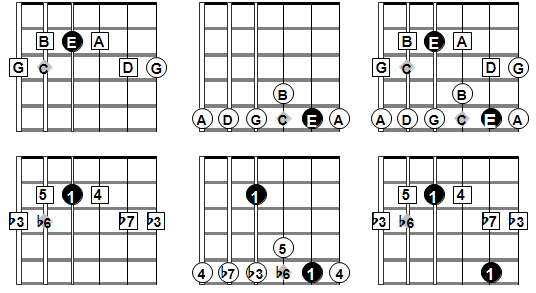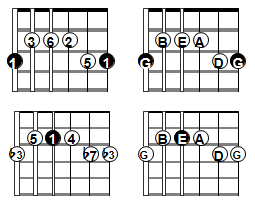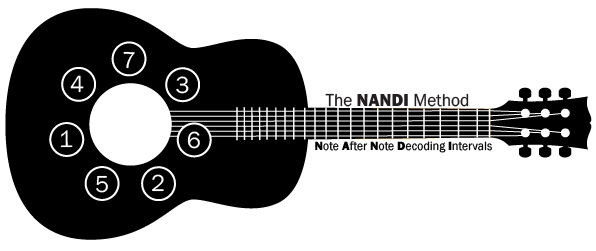The Pentatonic Scales
The pentatonic scales are some of the most important scales in the guitar realm. A pentatonic scale contains five notes, which is why we call it the Penta (5) tonic (tones) scale.
Let’s dig into each of these scales and find out a bit more!
The Major Pentatonic Scale
Watch the video below to learn how to identify the intervals in a major pentatonic scale using the Circle of Fourths:
We commonly find both major and minor pentatonic scales in pop and rock music. The major pentatonic scale has five notes that are built on scale degrees:
1 – 2 – 3 – 5 – 6
When we arrange those scale degrees in fourths, we get this:
3 – 6 – 2 – 5 – 1
Moving from 1 to 3, we get a major third.
The G Major Pentatonic scale is shown below, starting from the second fret on the fretboard. The top row shows the note names while the bottom row shows the scale degrees. You can use the CAGED shapes to help yourself navigate the pentatonic scale.
Below the scale notes are plotted in the E shape:


You can visualize the notes and intervals in the C major pentatonic scale following the order of fourths (3-6-2-5-1) across strings below.

The Minor Pentatonic Scale
Watch the video below to learn how to visualize the minor pentatonic scale using the Circle of Fourths:
The minor pentatonic scale is also composed of five notes. The difference is that it is built on scale degrees:
1 – ♭3 – 4 – 5 – ♭7
When we order those scale degrees in fourths, we get:
5 – 1 – 4 – ♭7 – ♭3
We know that all major scales have relative minor scales, and the same thing goes for major pentatonic scales and relative minor scales. If you move down three half-steps from G (F#-F-E), you get the root of a relative minor pentatonic scale, which is E.
Look at the diagrams below and you will see that the notes of the E minor pentatonic scale are the exact same notes of the G Major pentatonic scale. The only thing that differs between the two scales is the fact that they have different roots and interval structures.


Look at the chart below to compare these two scales side by side. You should take note of the minor third intervals between the two scales (3-5, 6-1, 2-4, 5-♭7, 1-♭3).


Begin with 5 (B) on any fret and follow the order of fourths (5-1-4-♭7-♭3 or B-E-A-D-G) across the same fret or two consecutive frets to visualize the notes and intervals of the E minor pentatonic scale in the illustrations below:

If you want to develop your skills in visualizing scales, I recommend the book “Guitar Scales Unleashed“. You will learn how to recognize interval patterns in the major, minor, pentatonic and blues scales (including modes) within the 5 CAGED shapes as well as octave displacement.
You can also download the accompanying namesake app for free on the Appstore and Google Play to take your practice to the next level!
